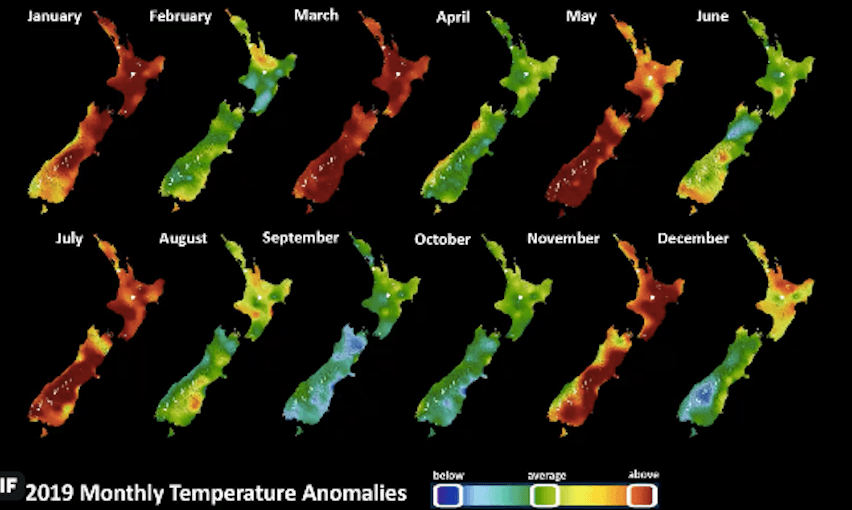Last year was the fourth hottest year on record for New Zealand, and scientists say it’s only getting hotter.
For the planet, and all of the people on it to survive, scientists the world over warn that we must stay within two degrees celsius of warming. Scientists and baby-faced Swedish activists alike know that the world is not on track to hit that target unless some serious changes happen to the way we produce carbon emissions. New NIWA data shows the effect of climate inaction on New Zealand in 2019.
What does the data say?
Basically it says, in no congratulatory tone, that New Zealand’s average temperature over 2019 was the fourth highest since records began. It was 0.76 degrees above the long-term average, at 13.76degC.
That’s average temperature, though. Surely some months were lower than average?
Actually, no. While six months of the year were measured to be sitting within a ‘near-average’ temperature, the other six months were above average. Sure some areas, especially in the South Island, experienced below average temperatures, but on average the country was heating up.
It was freezing in winter in Central Otago. Explain that?
It certainly was freezing in certain parts of the year for that region and for others, but nothing we haven’t had before. On the other end of the scale, however, four areas in New Zealand hit temperature records last year. Tauranga, Farewell Spit, Ngawi, and Kaikoura all reached their highest recorded temperatures, and 20 other locations experienced near-record highs.
Okay, so were last year’s high temperatures an outlier or a sign of an upward trend?
Definitely the latter. NIWA says there haven’t been any months with “below average” temperatures since 2017. This tweet shows how months with below average temperatures have decreased over time, while above average temperatures have been increasing.
It has now been 35 months since New Zealand had a month with below average temperatures.
This “climate donut ?” shows that cooler temperatures have become less common with time & illustrates the warmer world that we live in. pic.twitter.com/RKQ9qmIZwM
— NIWA Weather (@NiwaWeather) January 8, 2020
Why was it so hot?
A central Pacific El Niño started the year with some heat. Some coastal water temperatures were even designated as “marine heatwave conditions”, including around Canterbury and the Hawke’s Bay.
What about the rain?
It was a mixed bag for rain in 2019. Areas of the lower eastern South Island experienced near-record rainfall, but for Nelson and Tauranga/Hamilton it was a very different picture.
What happened there?
The Tauranga/Hamilton region had its third-longest drought on record, lasting 36 days, and in Nelson a 40-day drought led to what was described as New Zealand’s biggest wildfire in 72 years.
Is this year going to be even hotter?
It might not be, but as things are trending it’s sure to be high on the list of New Zealand’s warmest. NIWA says five of the past seven years have been among the warmest on record for the country: 2013, 2016, 2017, 2018 and 2019.
What’s the actual threat if temperatures rise?
Globally, the threat is huge, and could mean the displacement of millions of people worldwide as sea levels rise. As we’re currently seeing in Australia, bush fires and other natural disasters will become more frequent and last longer.
Will anything happen to us in New Zealand?
The Ministry for the Environment says if New Zealand keeps producing high emissions, there could be an increase in intense winter rainfalls, and coupled with an increase in droughts, this could mean far more flooding.
Higher temperatures will mean some of our flora and fauna are at greater risk of extinction, and the conditions could favour the spread of disease that will likely affect New Zealand’s biodiversity.
Anything else?
There are so many potential effects of climate change, and 99% of them are very, very bad. A slightly warmer beach to swim in is not worth all the horrible possible outcomes of temperature rises.
What can we do to stop it then?
Again, so many things. On a personal scale, there’s recently been a push to reduce or even eliminate meat consumption to limit the emissions produced through farming. There are so many ways to reduce plastic use in your everyday life, and people are getting more into cycling and using public transport to cut back their transport emissions.
One of the most crucial ways a person can make a difference is by voting for people with policies that address the climate crisis, and letting their elected representatives know where they stand on the issue, before it’s too late.

